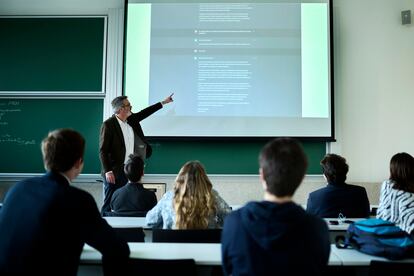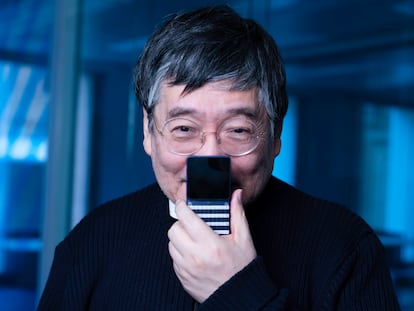AI in the classroom: ‘I require my students to use ChatGPT’
The new artificial intelligence application that signed up millions of users in a few months could disrupt educational paradigms

“I burned all my bridges on the first day,” says Professor Francesc Pujol of the University of Navarra (Spain). “In the semester’s first class, I said: ‘Welcome to this course. There are quite a few assignments, and you will have to use ChatGPT in all of them.” After that introduction, there was no backing out. Pujol had to redesign every assignment to incorporate ChatGPT, the new artificial intelligence (AI) tool spreading like wildfire around the globe
“When I presented my plan in class, 90% of the students didn’t know what it was, and I got worried,” Pujol says. “But the situation is dramatically different now.” Pujol, who teaches economics, business and design, believes his approach has obvious advantages. “Instead of using it to beat the system, the students use ChatGPT constructively.” In other words, they don’t use it to cut corners and generate ready-made homework assignments.
Education is one of the most prominent and potentially disruptive applications for ChatGPT. While the free version is more limited than the paid option, it can still be used in many ways. It can summarize long lessons in impeccable English (and other languages), use simple words to explain complex problems and write synopses of philosophical theories. It’s ideal for doing homework, answering questions, writing essays, formulas, or even computer code.
“We’ll probably get an A″
EL PAÍS spoke with a dozen teachers and students over the last few weeks and was hard-pressed to find a teacher who has not mentioned it in class. Students expressed surprise at how it can help them in their schoolwork. “Everyone in our project team knew about it, except for one girl, and it was incredibly helpful for our work,” says a 17-year-old student from Madrid. “We’ll probably get an A because of it.” The assignment was to develop a business plan, and the students were having trouble thinking of weaknesses, strengths and potential customers. “We asked ChatGPT to expand on our input, and we copied everything it produced after deleting some examples that we felt were too complex to be ours. But that’s all,” she said.
The student and her classmates quickly found another way of using ChatGPT. “I know people often use it to create summaries of history topics and narratives. They’ll give us a topic of three to five pages, and you just copy it into ChatGPT and ask for a 50-sentence summary. It does all the work, and they are excellent summaries,” she said.
Professors know all the tricks
Applications like ChatGPT will probably proliferate in academic settings. Every teacher will have to figure out how to deal with the impact without imposing an outright ban. “Since the beginning of time, we have dealt with every new shortcut or cheating scheme that comes up,” says Jesús Mañá, a recently retired teacher from the Fray Pedro de Urbina high school in Miranda de Ebro in northern Spain. “A teacher knows the type of language kids use, so it’s very easy to spot atypical words, adjectives, concepts, and expressions. That’s why oral tests are so useful.” Mañá believes that applications like ChatGPT can be helpful in academic settings with the proper support and guidance.
If a teacher says he knows about AI tools, students will be less likely to use them to cheat. “I gave my students a few activities using ChatGPT, which made it obvious that I knew about it,” says Lola Torres, a language teacher in Barcelona. “We’re going to use it in class so they can get more out of it.”
That’s the challenge – how to get the most out of these tools. “I tell my students that ChatGPT can provide faster answers, but they’ll learn less,” says Pujol. “Or, they can use it to learn better. If used to do the work for you, it overrides your ability to think independently, analyze and research. If used to support this critical thinking and reflection process, it can enhance your analytical abilities.”
It also makes mistakes
While its answers may sound convincing, ChatGPT often makes mistakes and confuses concepts. A 20-year-old student from Navarra (northern Spain) told EL PAÍS that ChatGPT didn’t help very much on a recent assignment. “I requested 200 words about a vacuum test in a refrigeration installation,” he said. “But it gave me a superficial answer, which is not what I wanted. It’s a specific subject – cold storage and air conditioning – so maybe it didn’t know much about that.” His own knowledge enabled him to improve ChatGPT’s response. “For technical topics, you need to know something about what you’re asking.”
Each subject broached with ChatGPT is a bit different. Asking for an exercise with English verbs is not the same as asking for a description of the precise functioning of a radiator sold only in the Canary Islands. Román Álvarez, a high school philosophy teacher in Salou, northeastern Spain, says: “ChatGPT is to other subjects what the Google translator was to English.” After testing ChatGPT, Álvarez wrote an email alerting all the teachers at his school about the tool. “Either we ride the wave, or it sinks us,” he says. Teachers are of different minds about it. “They are going through the stages of grief. Many are in denial – they hunt for mistakes and say, ‘How silly or how awful,’” adds Pujol.
The students know what they are doing
Román Álvarez recently gave his students their first assignment using ChatGPT – ask questions for the machine to answer as if it were Thomas Kuhn, a philosopher of science. On the first day of class, he wrote “ChatGPT” on the board and asked if anyone knew about it. “We were very surprised,” says a student. “We’re used to hearing other professors talk negatively about the internet, so it was weird to hear one telling us to use it. It was an interesting way of applying the chatbot!”
Teachers seem cautious or uneasy about ChatGPT, while their students are quietly enthusiastic and have a natural intuition about the advantages and limitations of the tool. Enrique Muñoz, a 23-year-old graduate student in business administration and finance, says: “It can do some basic groundwork to get you started, which is sometimes the hard part. But then you have to dive deeper on your own. It’s like training wheels on a bike – they help you learn, but you can go further after taking them off.”
Muñoz used ChatGPT for a paper on information protection law. After spending a lot of time reading textbooks, he says, “I didn’t understand half of it. So I gave it a try, and, to my surprise, it produced a text that was quite long but very easy to understand. It helped me understand the subject better.”
Teachers are skeptical
Some professors are concerned that these ChatGPT “aids” are inaccurate and could mislead students. “University students are still learning how to construct logical arguments and argue their points of view. These tools can shortcut that process,” says Víctor Pérez Hernández, a professor at the Ibero-American University in Mexico. “They may no longer learn how to write clearly and coherently, but they will have to learn how to give precise instructions to the AI machine and assess the answers it provides. We still don’t know much about the long-term consequences.”
There are no instant experts, especially not on a tool still under development. “My goal is not to become an expert, nor for my students to become one, but to provide them with knowledge so they can take advantage of these technologies,” says Jorge Ordovás, a professor at Spain’s European University. Pujol asks students to include screenshots in their assignments to see how they used ChatGPT. “We start with individual learning and then follow up with collective learning in the classroom when we discuss the assignment,” he says. “I present the best examples of how students phrased and refined their instructions to ChatGPT,” which he hopes will help everyone improve.
Learning how to use the tool
Lucas Pose, a language and literature teacher, views ChatGPT as an aid to the writing process. “The writing process is more important than the writing itself. If the assignment is to write a description, first I explain how description works – its structure and form – and then the students practice what they have learned. They write short drafts in class that I correct for things I want them to pay attention to, and little by little, they write better narratives. It’s more productive than just handing in a one-off homework assignment. Most of the work has been done in the classroom, so AI-generated text won’t help them much. The final write-up is just the icing on the cake.”
Most teachers with advanced methods of evaluating students treat these AI tools with a healthy dose of skepticism. “I evaluate students on how they think independently using certain materials,” says Alberto Ribes, a sociology professor at Madrid’s Complutense University. “I’m neither a naysayer nor an evangelist for these AI tools. It seems to be just another resource for students. Some will use it well, and others won’t.”
Sign up for our weekly newsletter to get more English-language news coverage from EL PAÍS USA Edition
Tu suscripción se está usando en otro dispositivo
¿Quieres añadir otro usuario a tu suscripción?
Si continúas leyendo en este dispositivo, no se podrá leer en el otro.
FlechaTu suscripción se está usando en otro dispositivo y solo puedes acceder a EL PAÍS desde un dispositivo a la vez.
Si quieres compartir tu cuenta, cambia tu suscripción a la modalidad Premium, así podrás añadir otro usuario. Cada uno accederá con su propia cuenta de email, lo que os permitirá personalizar vuestra experiencia en EL PAÍS.
¿Tienes una suscripción de empresa? Accede aquí para contratar más cuentas.
En el caso de no saber quién está usando tu cuenta, te recomendamos cambiar tu contraseña aquí.
Si decides continuar compartiendo tu cuenta, este mensaje se mostrará en tu dispositivo y en el de la otra persona que está usando tu cuenta de forma indefinida, afectando a tu experiencia de lectura. Puedes consultar aquí los términos y condiciones de la suscripción digital.











































